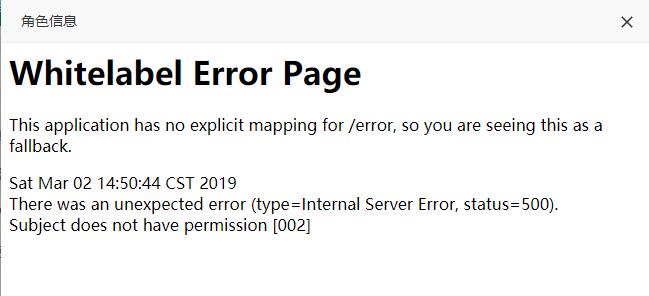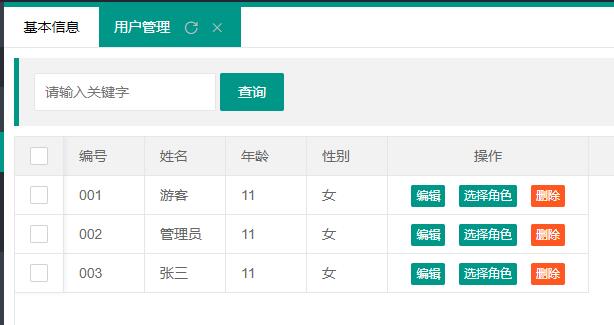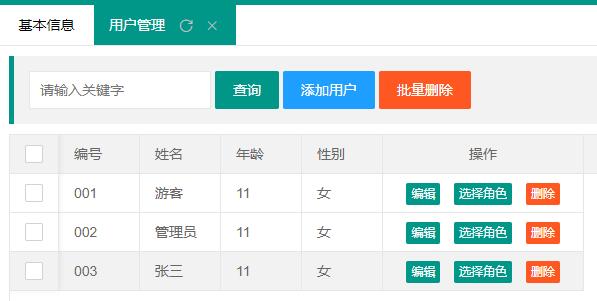用户权限管理一般是对用户页面、按钮的访问权限管理。Shiro框架是一个强大且易用的Java安全框架,执行身份验证、授权、密码和会话管理,对于Shiro的介绍这里就不多说。本篇博客主要是了解Shiro的基础使用方法,在权限管理系统中集成Shiro实现登录、url和页面按钮的访问控制。
一、引入依赖
使用SpringBoot集成Shiro时,在pom.xml中可以引入shiro-spring-boot-web-starter。由于使用的是thymeleaf框架,thymeleaf与Shiro结合需要 引入thymeleaf-extras-shiro。
<!-- https://mvnrepository.com/artifact/org.apache.shiro/shiro-spring-boot-web-starter --> <dependency> <groupId>org.apache.shiro</groupId> <artifactId>shiro-spring-boot-web-starter</artifactId> <version>1.4.0</version> </dependency> <!-- https://mvnrepository.com/artifact/com.github.theborakompanioni/thymeleaf-extras-shiro --> <dependency> <groupId>com.github.theborakompanioni</groupId> <artifactId>thymeleaf-extras-shiro</artifactId> <version>2.0.0</version> </dependency>
二、增加Shiro配置
有哪些url是需要拦截的,哪些是不需要拦截的,登录页面、登录成功页面的url、自定义的Realm等这些信息需要设置到Shiro中,所以创建Configuration文件ShiroConfig。

package com.example.config; import org.apache.shiro.mgt.SecurityManager; import org.apache.shiro.spring.web.ShiroFilterFactoryBean; import org.apache.shiro.web.mgt.DefaultWebSecurityManager; import org.springframework.beans.factory.annotation.Qualifier; import org.springframework.context.annotation.Bean; import org.springframework.context.annotation.Configuration; import at.pollux.thymeleaf.shiro.dialect.ShiroDialect; import java.util.LinkedHashMap; import java.util.Map; @Configuration public class ShiroConfig { @Bean("shiroFilterFactoryBean") public ShiroFilterFactoryBean shiroFilterFactoryBean(SecurityManager securityManager) { System.out.println("ShiroConfiguration.shirFilter()"); ShiroFilterFactoryBean shiroFilterFactoryBean = new ShiroFilterFactoryBean(); shiroFilterFactoryBean.setSecurityManager(securityManager); //拦截器. Map<String,String> filterChainDefinitionMap = new LinkedHashMap<String,String>(); // 配置不会被拦截的链接 顺序判断 filterChainDefinitionMap.put("/static/**", "anon"); //配置退出 过滤器,其中的具体的退出代码Shiro已经替我们实现了 filterChainDefinitionMap.put("/logout", "logout"); //<!-- 过滤链定义,从上向下顺序执行,一般将/**放在最为下边 -->:这是一个坑呢,一不小心代码就不好使了; //<!-- authc:所有url都必须认证通过才可以访问; anon:所有url都都可以匿名访问--> filterChainDefinitionMap.put("/**", "authc"); // 如果不设置默认会自动寻找Web工程根目录下的"/login.jsp"页面 shiroFilterFactoryBean.setLoginUrl("/login"); // 登录成功后要跳转的链接 shiroFilterFactoryBean.setSuccessUrl("/index"); //未授权界面; shiroFilterFactoryBean.setUnauthorizedUrl("/403"); shiroFilterFactoryBean.setFilterChainDefinitionMap(filterChainDefinitionMap); return shiroFilterFactoryBean; } @Bean(name="defaultWebSecurityManager") //创建DefaultWebSecurityManager public DefaultWebSecurityManager getDefaultWebSecurityManager(@Qualifier("userRealm")MyShiroRealm userRealm){ DefaultWebSecurityManager defaultWebSecurityManager = new DefaultWebSecurityManager(); defaultWebSecurityManager.setRealm(userRealm); return defaultWebSecurityManager; } //创建Realm @Bean(name="userRealm") public MyShiroRealm getUserRealm(){ return new MyShiroRealm(); } @Bean public ShiroDialect shiroDialect() { return new ShiroDialect(); } }
ShiroDialect这个bean对象是在thymeleaf与Shiro结合,前端html访问Shiro时使用。
三、自定义Realm
在自定义的Realm中继承了AuthorizingRealm抽象类,重写了两个方法:doGetAuthorizationInfo和doGetAuthenticationInfo。doGetAuthorizationInfo主要是用来处理权限配置,doGetAuthenticationInfo主要处理身份认证。这里在doGetAuthorizationInfo中,将role表的id和permission表的code分别设置到SimpleAuthorizationInfo对象中的role和permission中。还有一个地方需要注意:@Component("authorizer"),刚开始我没设置,但报错提示需要一个authorizer的bean,查看AuthorizingRealm可以发现它implements了Authorizer,所以在自定义的realm上添加@Component("authorizer")就可以了。

package com.example.config; import org.apache.shiro.authc.AuthenticationException; import org.apache.shiro.authc.AuthenticationInfo; import org.apache.shiro.authc.AuthenticationToken; import org.apache.shiro.authc.SimpleAuthenticationInfo; import org.apache.shiro.authz.AuthorizationInfo; import org.apache.shiro.authz.SimpleAuthorizationInfo; import org.apache.shiro.realm.AuthorizingRealm; import org.apache.shiro.subject.PrincipalCollection; import org.springframework.beans.factory.annotation.Autowired; import org.springframework.stereotype.Component; import com.example.pojo.Permission; import com.example.pojo.Role; import com.example.pojo.User; import com.example.service.RoleService; import com.example.service.UserService; @Component("authorizer") public class MyShiroRealm extends AuthorizingRealm { @Autowired private UserService userService; @Autowired private RoleService roleService; @Override protected AuthorizationInfo doGetAuthorizationInfo(PrincipalCollection principals) { System.out.println("权限配置-->MyShiroRealm.doGetAuthorizationInfo()"); SimpleAuthorizationInfo authorizationInfo = new SimpleAuthorizationInfo(); User user = (User)principals.getPrimaryPrincipal(); System.out.println("User:"+user.toString()+" roles count:"+user.getRoles().size()); for(Role role:user.getRoles()){ authorizationInfo.addRole(role.getId()); role=roleService.getRoleById(role.getId()); System.out.println("Role:"+role.toString()); for(Permission p:role.getPermissions()){ System.out.println("Permission:"+p.toString()); authorizationInfo.addStringPermission(p.getCode()); } } System.out.println("权限配置-->authorizationInfo"+authorizationInfo.toString()); return authorizationInfo; } /*主要是用来进行身份认证的,也就是说验证用户输入的账号和密码是否正确。*/ @Override protected AuthenticationInfo doGetAuthenticationInfo(AuthenticationToken token) throws AuthenticationException { System.out.println("MyShiroRealm.doGetAuthenticationInfo()"); //获取用户的输入的账号. String username = (String)token.getPrincipal(); System.out.println(token.getCredentials()); //通过username从数据库中查找 User对象,如果找到,没找到. //实际项目中,这里可以根据实际情况做缓存,如果不做,Shiro自己也是有时间间隔机制,2分钟内不会重复执行该方法 User user = userService.getUserById(username); System.out.println("----->>userInfo="+user); if(user == null){ return null; } SimpleAuthenticationInfo authenticationInfo = new SimpleAuthenticationInfo( user, //用户名 "123456", //密码 getName() //realm name ); return authenticationInfo; } }
四、登录认证
1.登录页面
这里做了一个非常丑的登录页面,主要是自己懒,不想在网上复制粘贴找登录页面了。

<!DOCTYPE html> <head> <meta charset="utf-8"> <title></title> <meta name="renderer" content="webkit"> <meta http-equiv="X-UA-Compatible" content="IE=edge,chrome=1"> <meta name="viewport" content="width=device-width, initial-scale=1, maximum-scale=1"> <meta name="apple-mobile-web-app-status-bar-style" content="black"> <meta name="apple-mobile-web-app-capable" content="yes"> <meta name="format-detection" content="telephone=no"> </head> <form action="/login" method="post"> <label>用户名:</label><input type="text" name="id" id="id" ><br> <label >密码:</label><input type="text" name="pwd" id="pwd" ><br> <button type="submit">登录</button><button type="reset">取消</button> </form> </body> </html>
2.处理登录请求
在LoginController中通过登录名、密码获取到token实现登录。

package com.example.controller; import org.apache.shiro.SecurityUtils; import org.apache.shiro.authc.IncorrectCredentialsException; import org.apache.shiro.authc.UnknownAccountException; import org.apache.shiro.authc.UsernamePasswordToken; import org.apache.shiro.subject.Subject; import org.springframework.stereotype.Controller; import org.springframework.ui.Model; import org.springframework.web.bind.annotation.RequestMapping; import org.springframework.web.bind.annotation.RequestMethod; @Controller public class LoginController { //退出的时候是get请求,主要是用于退出 @RequestMapping(value = "/login",method = RequestMethod.GET) public String login(){ return "login"; } //post登录 @RequestMapping(value = "/login",method = RequestMethod.POST) public String login(Model model,String id,String pwd){ //添加用户认证信息 Subject subject = SecurityUtils.getSubject(); UsernamePasswordToken usernamePasswordToken = new UsernamePasswordToken( id, "123456"); try { subject.login(usernamePasswordToken); return "home"; } catch (UnknownAccountException e) { //用户名不存在 model.addAttribute("msg","用户名不存在"); return "login"; }catch (IncorrectCredentialsException e) { //密码错误 model.addAttribute("msg","密码错误"); return "login"; } } @RequestMapping(value = "/index") public String index(){ return "home"; } }
五、Controller层访问控制
1.首先来数据库的数据,两张图是用户角色、和角色权限的数据。


2.设置权限
这里在用户页面点击编辑按钮时设置需要有id=002的角色,在点击选择角色按钮时需要有code=002的权限。
@RequestMapping(value = "/edit",method = RequestMethod.GET) @RequiresRoles("002")//权限管理; public String editGet(Model model,@RequestParam(value="id") String id) { model.addAttribute("id", id); return "/user/edit"; }
@RequestMapping(value = "/selrole",method = RequestMethod.GET) @RequiresPermissions("002")//权限管理; public String selctRole(Model model,@RequestParam("id") String id,@RequestParam("type") Integer type) { model.addAttribute("id",id); model.addAttribute("type", type); return "/user/selrole"; }
当使用用户001登录时,点击编辑,弹出框如下,提示没有002的角色

点击选择角色按钮时提示没有002的权限。

当使用用户002登录时,点击编辑按钮,显示正常,点击选择角色也是提示没002的权限,因为权限只有001。
六、前端页面层访问控制
有时为了不想像上面那样弹出错误页面,需要在按钮显示上进行不可见,这样用户也不会点击到。前面已经引入了依赖并配置了bean,这里测试下在html中使用shiro。
1.首先设置html标签引入shiro
<html xmlns:th="http://www.thymeleaf.org" xmlns:shiro="http://www.pollix.at/thymeleaf/shiro">
2.控制按钮可见
这里使用shiro:hasAnyRoles="002,003"判断用户角色是否是002或003,是则显示不是则不显示。
<div class="layui-inline"> <a shiro:hasAnyRoles="002,003" class="layui-btn layui-btn-normal newsAdd_btn" onclick="addUser('')">添加用户</a> </div> <div class="layui-inline"> <a shiro:hasAnyRoles="002,003" class="layui-btn layui-btn-danger batchDel" onclick="getDatas();">批量删除</a> </div>
当001用户登录时,添加用户、批量删除按钮都不显示,只显示查询按钮。

当002用户登录时,添加用户、批量删除按钮都显示

七、小结
这里只是实现了Shiro的简单的功能,Shiro还有很多很强大的功能,比如session管理等,而且目前权限管理模块还有很多需要优化的功能,左侧导航栏的动态加载和权限控制、Shiro与Redis结合实现session共享、Shiro与Cas结合实现单点登录等。后续可以把项目做为开源项目,慢慢完善集成更多模块例如:Swagger2、Redis、Druid、RabbitMQ等供初学者参考。
